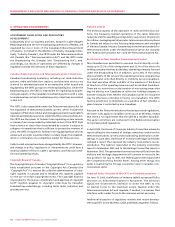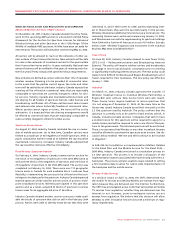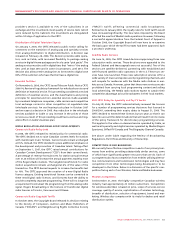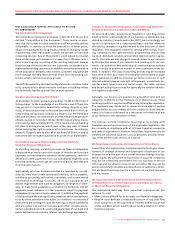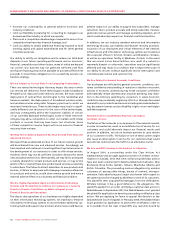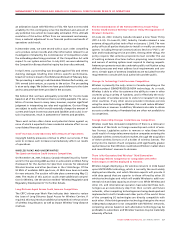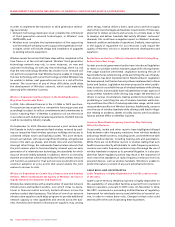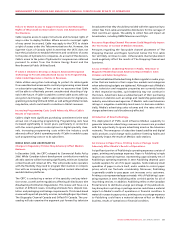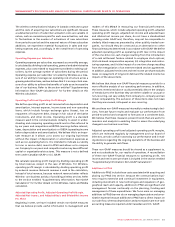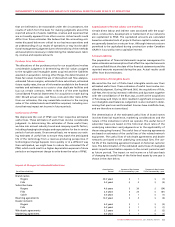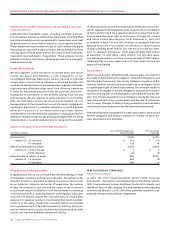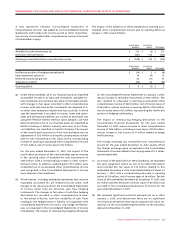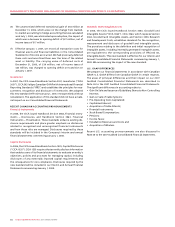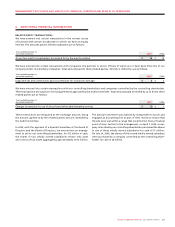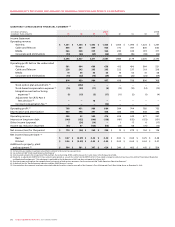Rogers 2007 Annual Report Download - page 64
Download and view the complete annual report
Please find page 64 of the 2007 Rogers annual report below. You can navigate through the pages in the report by either clicking on the pages listed below, or by using the keyword search tool below to find specific information within the annual report.
60 ROGERS COMMUNICATIONS INC. 2007 ANNUAL REPORT
MANAGEMENT’S DISCUSSION AND ANALYSIS OF FINANCIAL CONDITION AND RESULTS OF OPERATIONS
represents monthly network revenue divided by the average num-
ber of subscribers during the month. ARPU, when used in connection
with a particular type of subscriber, represents monthly revenue
generated from those subscribers divided by the average number
of those subscribers during the month. When used or reported for
a period greater than one month, ARPU represents the monthly
average of the ARPU calculations for the period. We believe ARPU
helps indicate whether we have been successful in attracting and
retaining higher value subscribers. Refer to the section entitled
“Supplementary Information: Non-GAAP Calculations” for further
details on this Wireless and Cable calculation.
Operating Expenses
Operating expenses are segregated into three categories for assess-
ing business performance:
• Costofsales,whichiscomprisedofwirelessequipmentcosts,
Rogers Retail merchandise and depreciation of Rogers Retail rental
assets, as well as cost of goods sold by The Shopping Channel;
• Sales and marketing expenses, which represent the costs to
acquire new subscribers (other than those related to equipment),
such as advertising, commissions paid to third parties for new
activations, remuneration and benefits to sales and marketing
employees, as well as direct overheads related to these activities
and the costs of operating the Rogers Retail store locations; and
• Operating,generalandadministrativeexpenses,whichinclude
all other expenses incurred to operate the business on a day-to-
day basis and service existing subscriber relationships, including
retention costs, inter-carrier payments to roaming partners and
long-distance carriers, network maintenance costs, programming
related costs, the CRTC contribution levy, Internet and e-mail
services and printing and production costs.
In the wireless and cable industries in Canada, the demand for ser-
vices continues to grow and the variable costs, such as commissions
paid for subscriber activations, as well as the fixed costs of acquir-
ing new subscribers, are significant. Fluctuations in the number of
activations of new subscribers from period-to-period and the sea-
sonal nature of both wireless and cable subscriber additions result
in fluctuations in sales and marketing expenses and accordingly, in
the overall level of operating expenses. In our Media business, sales
and marketing expenses may be significant to promote publishing,
radio and television properties, which in turn attract advertisers,
viewers, listeners and readers.
Sales and Marketing Costs (or Cost of Acquisition) Per Subscriber
Sales and marketing costs per subscriber, which is also often referred
to in the Wireless industry as cost of acquisition per subscriber
(“COA”), “subscriber acquisition cost”, or “cost per gross addition”,
is calculated by dividing total sales and marketing expenditures,
plus costs related to equipment provided to new subscribers for
the period, by the total number of gross subscriber activations dur-
ing the period. Subscriber activations include postpaid and prepaid
voice and data activations and one-way messaging activations.
COA, as it relates to a particular activation, can vary depending
on the level of ARPU and term of a subscriber’s contract. Refer
to the section entitled “Supplementary Information: Non-GAAP
Calculations” for further details on the calculation.
5. ACCOUNTING POLICIES AND NON-GAAP MEASURES
KEY PERFORMANCE INDICATORS AND NON-GAAP MEASURES
We measure the success of our strategies using a number of key
performance indicators, which are outlined below. The following
key performance indicators are not measurements in accordance
with Canadian or U.S. GAAP and should not be considered as an
alternative to net income or any other measure of performance
under Canadian or U.S. GAAP.
Subscriber Counts
We determine the number of subscribers to our services based on
active subscribers. A wireless subscriber is represented by each
identifiable telephone number. A cable subscriber is represented
by a dwelling unit. In the case of multiple units in one dwelling,
such as an apartment building, each tenant with cable service,
whether invoiced individually or having services included in his or
her rent, is counted as one subscriber. Commercial or institutional
units, such as hospitals or hotels, are each considered to be one
subscriber. When subscribers are deactivated, either voluntarily or
involuntarily for non-payment, they are considered to be deactiva-
tions in the period the services are discontinued. Wireless prepaid
subscribers are considered active for a period of 180 days from the
date of their last revenue-generating usage.
We report wireless subscribers in two categories: postpaid and
prepaid. Postpaid includes voice-only and data-only subscribers,
as well as subscribers with service plans integrating both voice and
data, while prepaid includes voice-only subscribers.
Internet, Rogers Home Phone and RBS subscribers include only
those subscribers with service installed, operating and on billing
and excludes those subscribers who have subscribed to the service
but for whom installation of the service was still pending.
Subscriber Churn
Subscriber churn is calculated on a monthly basis. For any particular
month, subscriber churn for Wireless represents the number of
subscribers deactivating in the month divided by the aggregate
number of subscribers at the beginning of the month. When used or
reported for a period greater than one month, subscriber churn rep-
resents the monthly average of the subscriber churn for the period.
Network Revenue
Network revenue, used in the Wireless segment, represents total
Wireless revenue less revenue received from the sale of handset
equipment. The sale of such equipment does not materially affect
our operating income as we generally sell equipment to our dis-
tributors at a price approximating our cost to facilitate competitive
pricing at the retail level. Accordingly, we believe that network rev-
enue is a more relevant measure for Wireless’ ability to increase its
operating profit, as defined below.
Average Revenue Per User
ARPU is calculated on a monthly basis. For any particular month,
ARPU represents monthly revenue divided by the average num-
ber of subscribers during the month. In the case of Wireless, ARPU


